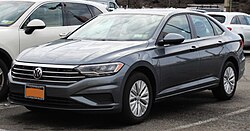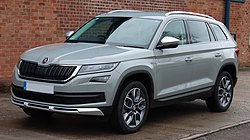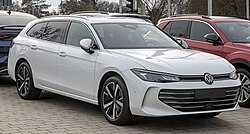| Volkswagen Group MQB platform | |
|---|---|
 "MQB Bodengruppe" Volkswagen MQB floor assembly on display at the 2012 Hannover Messe. | |
| Overview | |
| Manufacturer | Volkswagen Group |
| Production | 2012–present |
| Body and chassis | |
| Layout | |
| Chronology | |
| Predecessor | PQ25 platform PQ35 platform PQ46 platform |
The Volkswagen Group MQB platform is the company's strategy for shared modular design construction of its transverse, front-engine, front-wheel-drive layout (optional front-engine, four-wheel-drive layout) automobiles. It was first introduced in the Volkswagen Golf Mk7 in late 2012. Volkswagen spent roughly $8bn [1] developing this new platform and the cars employing it. The platform underpins a wide range of cars from the supermini class to the mid size SUV class. MQB allows Volkswagen to assemble any of its cars based on this platform across all of its MQB ready factories. This allows the Volkswagen group flexibility to shift production as needed between its different factories. Beginning in 2012, Volkswagen Group marketed the strategy under the code name MQB, which stands for Modularer Querbaukasten, translating from German to "Modular Transversal Toolkit" or "Modular Transverse Matrix". [2] [3] MQB is one strategy within VW's overall MB (Modularer Baukasten or modular matrix) program which also includes the similar MLB strategy for vehicles with longitudinal engine orientation. [4]
Contents
- Press comments
- MQB-based models
- First generation MQB (2012)
- Second generation MQB (MQB Ax; 2016)
- MQB Evo (2019)
- See also
- References
- External links
MQB is not a platform as such, but, rather, a system for introducing rationality to different platforms that have transverse engines, regardless of the ten body configurations the company manufactures for any of its eleven vehicle brands. Thus MQB coordinates a core "matrix" of components across a wide variety of platforms — for example, sharing a common engine-mounting core for all drivetrains (e.g., gasoline, diesel, natural gas, hybrid and purely electric), as well as reducing weight. The concept allows different models to be manufactured at the same plant, further saving cost. [4] [5]
Ulrich Hackenberg, chief of Volkswagen’s Research and Development (Head of Audi Development until 2015), called MQB a "strategic weapon." [4]








































































